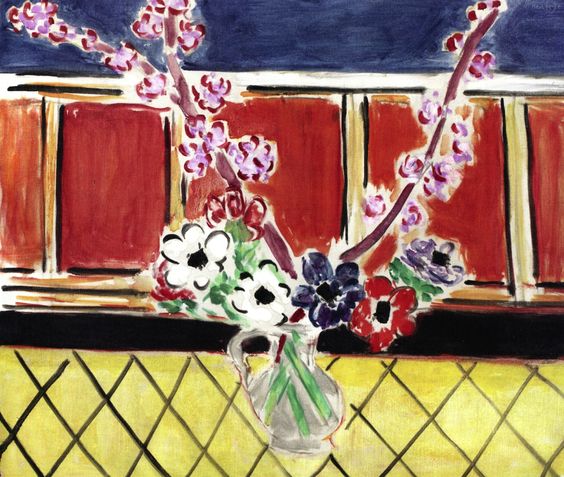Description
Henri Matisse, one of the giants of modern painting, offers us in "Anemones and Peach Blossoms" a window into his particular aesthetic, imbued with a vibrant use of color and an elegant compositional simplicity. The work, created in 1944, measures 57 x 48 cm and is a palpable testimony to Matisse's mature style, focusing on the intrinsic beauty of the natural world through his unmistakable lens.
The central theme of "Anemones and Peach Blossoms" is, as the title suggests, flowers. The anemones are predominantly depicted in vases, accompanied by peach blossoms, a combination that radiates a vivid celebration of nature. Matisse employs a bright and contrasting color palette that showcases his mastery of color use. The reds and pinks of the anemones juxtapose with the delicate peaches and greens of the peach branches, creating a visual balance that is both harmonious and dynamic.
Observing the composition, one can appreciate how Matisse arranges the flowers on the canvas in a deliberate yet seemingly carefree manner. The anemones, with their broad and striking petals, have a visual prominence, while the peach blossoms, with softer tones, complement and soften the scene. So characteristic of Matisse's work is the ability to invoke the freshness and vitality of his subjects using seemingly simple forms, but loaded with intention.
The background of the work is notably abstract, using flat color blocks that frame the flowers without distracting from the main focus. This technique further highlights the intensity of the flower colors, emphasizing their vibrancy and purity. Matisse, influenced by Fauvism, of which he was one of the main exponents, maintains in this work his passion for pure colors and the simplification of form, transforming the everyday into something extraordinary.
Although "Anemones and Peach Blossoms" does not contain human characters, the interaction of the floral elements personifies a certain anthropomorphic quality, a silent dialogue of forms and colors that suggest movement and life. This ability to infuse character into the inanimate is one of Matisse's distinctive marks, a reflection of his deep understanding of nature and his ability to reinterpret it through his work.
This painting also stands out for its historical context. Painted in 1944, during a tumultuous period in Europe, "Anemones and Peach Blossoms" emerges as a haven of peace and beauty. While the world was in the midst of World War II, Matisse achieved in his studio a form of artistic resistance, celebrating life through his flowers. The work, with its beauty and simplicity, offers a strong contrast to the chaos of its time, and underscores the capacity of art to provide escape and solace in moments of adversity.
The beauty of "Anemones and Peach Blossoms" lies not only in its visual appearance but in what it represents: a moment of artistic individuality and peaceful resistance. Henri Matisse invites us, once again, to see the world in a brighter and more vital way, celebrating the extraordinary beauty in the everyday. This work is a clear example of why Matisse remains a central figure in the canon of modern art, and his legacy continues to inspire and enchant new generations of art lovers.

